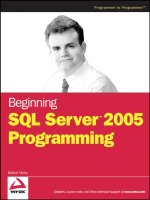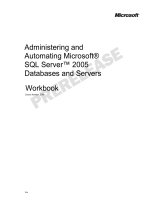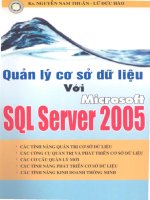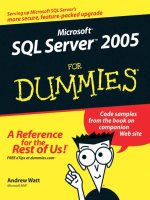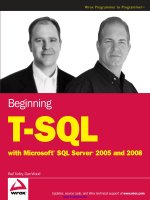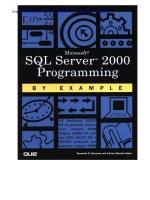Microsoft SQL server 2005 programming for dummies apr 2007
Bạn đang xem bản rút gọn của tài liệu. Xem và tải ngay bản đầy đủ của tài liệu tại đây (5.28 MB, 435 trang )
www.sharexxx.net - free books & magazines
Microsoft®
™
SQL Server 2005
Programming
FOR
DUMmIES
by Andrew Watt
‰
Microsoft®
™
SQL Server 2005
Programming
FOR
DUMmIES
by Andrew Watt
‰
Microsoft® SQL Server™ 2005 Programming For Dummies®
Published by
Wiley Publishing, Inc.
111 River Street
Hoboken, NJ 07030-5774
www.wiley.com
Copyright © 2007 by Wiley Publishing, Inc., Indianapolis, Indiana
Published by Wiley Publishing, Inc., Indianapolis, Indiana
Published simultaneously in Canada
No part of this publication may be reproduced, stored in a retrieval system or transmitted in any form or
by any means, electronic, mechanical, photocopying, recording, scanning or otherwise, except as permitted under Sections 107 or 108 of the 1976 United States Copyright Act, without either the prior written
permission of the Publisher, or authorization through payment of the appropriate per-copy fee to the
Copyright Clearance Center, 222 Rosewood Drive, Danvers, MA 01923, (978) 750-8400, fax (978) 646-8600.
Requests to the Publisher for permission should be addressed to the Legal Department, Wiley Publishing,
Inc., 10475 Crosspoint Blvd., Indianapolis, IN 46256, (317) 572-3447, fax (317) 572-4355, or online at
/>Trademarks: Wiley, the Wiley Publishing logo, For Dummies, the Dummies Man logo, A Reference for the
Rest of Us!, The Dummies Way, Dummies Daily, The Fun and Easy Way, Dummies.com, and related trade
dress are trademarks or registered trademarks of John Wiley & Sons, Inc. and/or its affiliates in the United
States and other countries, and may not be used without written permission. Microsoft and SQL Server
are trademarks or registered trademarks of Microsoft Corporation in the United States and/or other countries. All other trademarks are the property of their respective owners. Wiley Publishing, Inc., is not associated with any product or vendor mentioned in this book.
LIMIT OF LIABILITY/DISCLAIMER OF WARRANTY: THE PUBLISHER AND THE AUTHOR MAKE NO REPRESENTATIONS OR WARRANTIES WITH RESPECT TO THE ACCURACY OR COMPLETENESS OF THE CONTENTS OF THIS WORK AND SPECIFICALLY DISCLAIM ALL WARRANTIES, INCLUDING WITHOUT
LIMITATION WARRANTIES OF FITNESS FOR A PARTICULAR PURPOSE. NO WARRANTY MAY BE CREATED OR EXTENDED BY SALES OR PROMOTIONAL MATERIALS. THE ADVICE AND STRATEGIES CONTAINED HEREIN MAY NOT BE SUITABLE FOR EVERY SITUATION. THIS WORK IS SOLD WITH THE
UNDERSTANDING THAT THE PUBLISHER IS NOT ENGAGED IN RENDERING LEGAL, ACCOUNTING, OR
OTHER PROFESSIONAL SERVICES. IF PROFESSIONAL ASSISTANCE IS REQUIRED, THE SERVICES OF A
COMPETENT PROFESSIONAL PERSON SHOULD BE SOUGHT. NEITHER THE PUBLISHER NOR THE
AUTHOR SHALL BE LIABLE FOR DAMAGES ARISING HEREFROM. THE FACT THAT AN ORGANIZATION
OR WEBSITE IS REFERRED TO IN THIS WORK AS A CITATION AND/OR A POTENTIAL SOURCE OF FURTHER INFORMATION DOES NOT MEAN THAT THE AUTHOR OR THE PUBLISHER ENDORSES THE INFORMATION THE ORGANIZATION OR WEBSITE MAY PROVIDE OR RECOMMENDATIONS IT MAY MAKE.
FURTHER, READERS SHOULD BE AWARE THAT INTERNET WEBSITES LISTED IN THIS WORK MAY HAVE
CHANGED OR DISAPPEARED BETWEEN WHEN THIS WORK WAS WRITTEN AND WHEN IT IS READ.
For general information on our other products and services, please contact our Customer Care
Department within the U.S. at 800-762-2974, outside the U.S. at 317-572-3993, or fax 317-572-4002.
For technical support, please visit www.wiley.com/techsupport.
Wiley also publishes its books in a variety of electronic formats. Some content that appears in print may
not be available in electronic books.
Library of Congress Control Number: 2006929469
ISBN: 978-0-471-77422-8
Manufactured in the United States of America
10 9 8 7 6 5 4 3 2 1
About the Author
Andrew Watt wrote his first computer programs back in 1985. He is an independent consultant, experienced author, and Microsoft MVP (Most Valuable
Professional) for SQL Server. His areas of interest and expertise include SQL
Server 2005, Windows PowerShell, XML, and Microsoft InfoPath.
Andrew first used SQL Server in version 7.0 and was an active participant in
the SQL Server 2005 beta program from August 2003.
Among the books Andrew has written, or co-written, are SQL Server 2005
For Dummies, Beginning Regular Expressions, Beginning XML (3rd edition),
Beginning RSS & Atom Programming, Professional XML (2nd edition), and
Designing SVG Web Graphics.
Andrew is often seen answering questions in Microsoft’s SQL Server and
other newsgroups. Feel free to get involved in the community there. He can
be contacted direct at Due to the volume of e-mail
he receives, he can’t guarantee to respond to every e-mail.
Dedication
To Jonathan, Stephen, Hannah, Jeremy, Peter, and Naomi. Each a very special
human being to me.
Author’s Acknowledgments
Every technical book is the product of teamwork, and this book is no exception. I particularly want to thank the technical editor, Damir Bersinic, who
came up with many useful comments and good suggestions for additional
material, but unfortunately, there wasn’t space to accept more than a few of
them. It would be nice if somebody invented elastic paper. Until then, books
are limited to being of a fixed size.
My thanks to Gavin Powell, who helped out with author review when other
authoring commitments for Wiley meant I couldn’t slice myself in half.
I would also like to thank my acquisitions editor on this book, Kyle Looper.
Thanks are particularly due to Kyle for his patience as time slipped. Isn’t that
supposed to happen only in science fiction books?
It’s been great working with Kim Darosett, my project editor, who has done so
much to move the project forward to a successful conclusion. I would also
like to thank Heidi Unger, copy editor, whose attention to detail picked up
some of those little errors that the rest of us had missed.
Thanks to all the team. It has been a good experience for me working with
you all.
Publisher’s Acknowledgments
We’re proud of this book; please send us your comments through our online registration form
located at www.dummies.com/register/.
Some of the people who helped bring this book to market include the following:
Acquisitions, Editorial, and
Media Development
Composition Services
Project Editor: Kim Darosett
Project Coordinator: Patrick Redmond
Copy Editor: Heidi Unger
Layout and Graphics: Claudia Bell,
Stephanie D. Jumper, Barbara Moore,
Ronald Terry
Technical Editor: Damir Bersinic
Proofreaders: Aptara, Christy Pingleton
Editorial Manager: Leah Cameron
Indexer: Aptara
Media Development Manager:
Laura VanWinkle
Anniversary Logo Design: Richard Pacifico
Senior Acquisitions Editor: Steven Hayes
Editorial Assistant: Amanda Foxworth
Sr. Editorial Assistant: Cherie Case
Cartoons: Rich Tennant (www.the5thwave.com)
Publishing and Editorial for Technology Dummies
Richard Swadley, Vice President and Executive Group Publisher
Andy Cummings, Vice President and Publisher
Mary Bednarek, Executive Acquisitions Director
Mary C. Corder, Editorial Director
Publishing for Consumer Dummies
Diane Graves Steele, Vice President and Publisher
Joyce Pepple, Acquisitions Director
Composition Services
Gerry Fahey, Vice President of Production Services
Debbie Stailey, Director of Composition Services
Contents at a Glance
Introduction .................................................................1
Part I: Get Started Using the SQL Server 2005
Development Environment .............................................7
Chapter 1: The Joy of SQL Server 2005 Programming ...................................................9
Chapter 2: Understanding Database Fundamentals ....................................................15
Chapter 3: Getting to Know the SQL Server Toolset....................................................25
Part II: Retrieving Data Using Transact-SQL.................45
Chapter 4: Retrieving Data Using the SELECT Statement ...........................................47
Chapter 5: Creating Joins ................................................................................................69
Chapter 6: Creating Advanced Queries .........................................................................91
Chapter 7: Manipulating Data .......................................................................................105
Part III: Creating Databases and Database
Objects with Transact-SQL ........................................123
Chapter 8: Designing, Creating, and Altering Database Objects ..............................125
Chapter 9: Designing, Creating, and Changing Tables ...............................................141
Chapter 10: Applying Constraints ................................................................................163
Chapter 11: Creating Views ...........................................................................................181
Chapter 12: Using Stored Procedures..........................................................................193
Chapter 13: Using Triggers............................................................................................209
Chapter 14: Creating Functions ....................................................................................227
Chapter 15: Creating Indexes ........................................................................................255
Chapter 16: Handling Errors Using TRY . . . CATCH ...................................................267
Part IV: Programming SQL Server Security .................281
Chapter 17: Adding Logins and Users..........................................................................283
Chapter 18: Creating Database-Level Security............................................................297
Chapter 19: Securing Data Using Encryption..............................................................307
Part V: Beyond Transact-SQL Programming ................319
Chapter 20: Working with XML .....................................................................................321
Chapter 21: Working with the Common Language Runtime .....................................341
Chapter 22: Using Visual Studio 2005 ..........................................................................351
Chapter 23: Working with SQL Server Management Objects....................................373
Part VI: The Part of Tens ...........................................389
Chapter 24: Ten Tips to Program Like a Pro ...............................................................391
Chapter 25: Ten Sources for More Information on SQL Server 2005 .......................395
Index .......................................................................399
Table of Contents
Introduction ..................................................................1
About SQL Server 2005 Programming For Dummies ...................................1
Foolish Assumptions .......................................................................................2
Conventions Used in This Book .....................................................................2
What You Don’t Have to Read ........................................................................3
How This Book Is Organized...........................................................................3
Part I: Get Started Using the SQL Server 2005
Development Environment................................................................3
Part II: Retrieving Data Using Transact-SQL........................................4
Part III: Creating Databases and Database Objects
with Transact-SQL ..............................................................................4
Part IV: Programming SQL Server Security.........................................4
Part V: Beyond Transact-SQL Programming .......................................4
Part VI: The Part of Tens .......................................................................5
Icons Used in This Book..................................................................................5
Where to Go from Here....................................................................................5
Part I: Get Started Using the SQL Server 2005
Development Environment ..............................................7
Chapter 1: The Joy of SQL Server 2005 Programming . . . . . . . . . . . . . . .9
Deciding Which Version of SQL Server 2005 to Use ..................................10
Gathering and Manipulating Data ................................................................11
Enforcing Business Rules for Your Database..............................................12
Ensuring SQL Server Security.......................................................................12
When Transact-SQL Isn’t Enough.................................................................13
Chapter 2: Understanding Database Fundamentals . . . . . . . . . . . . . . .15
Getting to Know the Database Engine .........................................................15
Discovering Database Objects......................................................................17
Introducing SQL Server Data Types.............................................................20
Getting Familiar with SQL Server Naming Rules ........................................21
Talking Transact-SQL .....................................................................................24
Chapter 3: Getting to Know the SQL Server Toolset . . . . . . . . . . . . . . .25
Exploring SQL Server Management Studio .................................................26
Launching SQL Server Management Studio......................................26
Discovering what types of queries you can create ..........................29
x
SQL Server 2005 Programming For Dummies
Creating a simple query with the Code Editor .................................30
Working with templates.......................................................................31
Creating a query with the Query Designer .......................................33
Evaluating the execution plan of a query..........................................35
Using the SQLCMD Utility .............................................................................36
Getting to Know the SQL Server Configuration Manager .........................37
Using Other SQL Server Programming Tools .............................................38
Visual Studio 2005 ................................................................................39
The Business Intelligence Development Studio ...............................39
Accessing SQL Server Books Online (BOL) ................................................39
Installing the SQL Server Sample Databases ..............................................42
AdventureWorks ...................................................................................43
Northwind and pubs ............................................................................44
Part II: Retrieving Data Using Transact-SQL .................45
Chapter 4: Retrieving Data Using the SELECT Statement . . . . . . . . . . .47
Exploring Your Database’s Objects..............................................................48
Introducing the SELECT Statement..............................................................52
Using the FROM Clause .................................................................................53
The WHERE Clause ........................................................................................55
Using comparison operators ..............................................................56
Combining comparison operators with AND, OR, or NOT .............57
Using other keywords with the WHERE clause ................................59
The ORDER BY Clause ...................................................................................64
The GROUP BY Clause...................................................................................65
Chapter 5: Creating Joins . . . . . . . . . . . . . . . . . . . . . . . . . . . . . . . . . . . . . .69
Understanding the Need for Joins ...............................................................70
Creating an Inner Join....................................................................................73
Using aliases for table names .............................................................76
Creating an inner join with SQL Server Management Studio..........77
Joining more than two tables..............................................................80
Creating an Outer Join...................................................................................84
Creating a Cross Join .....................................................................................88
Chapter 6: Creating Advanced Queries . . . . . . . . . . . . . . . . . . . . . . . . . .91
Using Subqueries............................................................................................91
Examining the EXISTS Keyword ...................................................................94
Using the CAST and CONVERT Functions...................................................96
Working with Common Table Expressions ...............................................100
Table of Contents
Chapter 7: Manipulating Data . . . . . . . . . . . . . . . . . . . . . . . . . . . . . . . . .105
Copying a Database .....................................................................................105
Adding Data Using INSERT..........................................................................111
Writing a basic INSERT statement....................................................111
Inserting data from another table ....................................................113
Inserting data into a table with an identity column.......................114
Removing Data Using DELETE....................................................................116
Changing Data Using UPDATE ....................................................................120
Transactional Control..................................................................................122
Part III: Creating Databases and Database
Objects with Transact-SQL .........................................123
Chapter 8: Designing, Creating, and Altering
Database Objects . . . . . . . . . . . . . . . . . . . . . . . . . . . . . . . . . . . . . . . . . . .125
Examining the Key Phases to Designing a Database ...............................125
Definition .............................................................................................126
Requirements......................................................................................127
Evaluation............................................................................................127
Design ..................................................................................................127
Implementation...................................................................................130
Documentation and testing...............................................................131
Delivery................................................................................................131
Maintenance........................................................................................131
Normalizing Data..........................................................................................131
First normal form................................................................................132
Second normal form...........................................................................134
Third normal form..............................................................................135
Designing Relationships ..............................................................................136
Creating Databases ......................................................................................136
Altering Databases .......................................................................................139
Dropping Databases.....................................................................................140
Chapter 9: Designing, Creating, and Changing Tables . . . . . . . . . . . .141
Choosing a Naming Scheme for Tables and Columns .............................141
Choosing Data Types for Columns.............................................................143
Exact numeric data types..................................................................143
Approximate numeric data types.....................................................145
Date- and time-related data types ....................................................146
Non-Unicode character data types ..................................................146
Unicode character data types ..........................................................147
Binary data types ...............................................................................147
Miscellaneous data types ..................................................................148
xi
xii
SQL Server 2005 Programming For Dummies
The CREATE TABLE statement ...................................................................149
Creating Relationships Using Transact-SQL .............................................151
Creating Tables Using SQL Server Management Studio ..........................154
Creating the database ........................................................................155
Creating the tables .............................................................................156
The ALTER TABLE Statement......................................................................161
Chapter 10: Applying Constraints . . . . . . . . . . . . . . . . . . . . . . . . . . . . . .163
Understanding the Types of Constraints ..................................................163
Creating NOT NULL Constraints ................................................................164
Creating DEFAULT Constraints ...................................................................168
Creating UNIQUE Constraints.....................................................................170
Creating CHECK Constraints.......................................................................173
Removing Constraints .................................................................................178
Using Advanced Constraints ......................................................................179
Chapter 11: Creating Views . . . . . . . . . . . . . . . . . . . . . . . . . . . . . . . . . . .181
What Is a View?.............................................................................................181
Understanding the Need for Views ............................................................182
Creating a View.............................................................................................183
Using Views for Security .............................................................................190
Updating through Views..............................................................................191
Indexing a View.............................................................................................192
Chapter 12: Using Stored Procedures . . . . . . . . . . . . . . . . . . . . . . . . . .193
Getting to Know Stored Procedures ..........................................................193
Why Use Stored Procedures? .....................................................................199
Creating a Stored Procedure.......................................................................200
Using ALTER to Change a Stored Procedure.............................................204
Using Parameters with Stored Procedures ...............................................206
Chapter 13: Using Triggers . . . . . . . . . . . . . . . . . . . . . . . . . . . . . . . . . . . .209
Using Events That Execute Triggers..........................................................210
Understanding Where and When to Use Triggers ...................................211
Using AFTER Triggers ..................................................................................213
Using INSTEAD OF Triggers ........................................................................220
Using DDL Triggers ......................................................................................223
Debugging Triggers ......................................................................................224
Chapter 14: Creating Functions . . . . . . . . . . . . . . . . . . . . . . . . . . . . . . . .227
What Is a Transact-SQL Function? .............................................................227
Creating User-Defined Functions ...............................................................228
Altering and Dropping Functions ...............................................................233
Using System Functions ..............................................................................234
Table of Contents
Chapter 15: Creating Indexes . . . . . . . . . . . . . . . . . . . . . . . . . . . . . . . . .255
Getting a Handle on Why You Might Need Indexes .................................256
Considering the Types of Indexes..............................................................258
Creating an Index .........................................................................................260
Altering an Index ..........................................................................................264
Dropping an Index........................................................................................266
Chapter 16: Handling Errors Using TRY . . . CATCH . . . . . . . . . . . . . . .267
Error Handling in Transact-SQL .................................................................268
Using the @@ERROR Function ....................................................................269
Using RAISERROR.........................................................................................272
Using TRY . . . CATCH...................................................................................274
Nesting TRY . . . CATCH Statements...........................................................279
Part IV: Programming SQL Server Security ..................281
Chapter 17: Adding Logins and Users . . . . . . . . . . . . . . . . . . . . . . . . . .283
Introducing SQL Server 2005 Security.......................................................284
Understanding Logins and Users ...............................................................287
Adding Logins ...............................................................................................288
Understanding Schemas and Users ...........................................................290
Using Schemas..............................................................................................291
Adding Users.................................................................................................293
Chapter 18: Creating Database-Level Security . . . . . . . . . . . . . . . . . .297
Assigning Permissions on Database Objects............................................297
Using Roles....................................................................................................302
Using Application Roles ..............................................................................303
Using Security Functions.............................................................................304
Chapter 19: Securing Data Using Encryption . . . . . . . . . . . . . . . . . . . .307
Introducing Encryption ...............................................................................307
Working with Asymmetric and Symmetric Encryption...........................314
Using Certificates .........................................................................................316
Encrypting Data............................................................................................317
Part V: Beyond Transact-SQL Programming .................319
Chapter 20: Working with XML . . . . . . . . . . . . . . . . . . . . . . . . . . . . . . . .321
XML in SQL Server 2005 ..............................................................................322
Using Typed and Untyped XML..................................................................323
xiii
xiv
SQL Server 2005 Programming For Dummies
Querying XML Data......................................................................................330
DML on XML data.........................................................................................332
Indexing XML ................................................................................................335
Exposing Relational Data as XML...............................................................336
Chapter 21: Working with the Common Language Runtime . . . . . . .341
Introducing the CLR.....................................................................................341
Understanding CLR Permissions................................................................344
Configuring SQL Server for the CLR ..........................................................345
Creating an Assembly ..................................................................................348
Chapter 22: Using Visual Studio 2005 . . . . . . . . . . . . . . . . . . . . . . . . . . .351
Using Server Explorer..................................................................................352
Using the Visual Designers..........................................................................356
Using Solution Explorer...............................................................................362
Creating a Project.........................................................................................364
Chapter 23: Working with SQL Server Management Objects . . . . . .373
Getting Started with SQL-SMO....................................................................373
Discovering the SQL-SMO Object Model...................................................374
Creating a SQL-SMO Program .....................................................................381
Part VI: The Part of Tens ............................................389
Chapter 24: Ten Tips to Program Like a Pro . . . . . . . . . . . . . . . . . . . . .391
Listen to Your Clients’ Needs .....................................................................391
Document the Project..................................................................................391
Budget Enough Time for the Project .........................................................392
Think about Long-Term Needs ...................................................................392
Think Carefully about Relations in the Database.....................................392
Handle Many-to-Many Relationships Appropriately ...............................393
Think about Performance ...........................................................................393
Design and Test on Development Hardware ............................................393
Test Your Application Carefully .................................................................394
Think about Which Edition of SQL Server to Use ....................................394
Think about the Hardware You Need ........................................................394
Chapter 25: Ten Sources for More Information
on SQL Server 2005 . . . . . . . . . . . . . . . . . . . . . . . . . . . . . . . . . . . . . . . . . .395
Books Online.................................................................................................395
The Public Newsgroups...............................................................................396
The Public Fora ............................................................................................396
Table of Contents
The SQL Server 2005 Web Site....................................................................397
The SQL Server Developer Center .............................................................397
The SQL Server 2005 TechCenter ..............................................................397
The Business Intelligence Site ....................................................................397
The Integration Services Developer Center..............................................397
The Reporting Services Web Site ...............................................................398
Channel 9.......................................................................................................398
Other Web Sites ............................................................................................398
Index........................................................................399
xv
xvi
SQL Server 2005 Programming For Dummies
Introduction
S
QL Server 2005 is Microsoft’s premier relational database product. It’s
the big brother of Microsoft Access — and is designed for serious business or enterprise database use, depending on the edition of SQL Server 2005
that you choose. SQL Server offers you enormous flexibility when creating
applications based on a SQL Server database. Unless your application
requirements are unusually demanding, you can probably find an edition of
SQL Server 2005 that allows you to create the application that you want.
About SQL Server 2005 Programming
For Dummies
SQL Server 2005 is an immensely powerful and flexible database program,
which means it’s almost certain that it can do what you want it to do. But to
make it perform as you want it to, you need to get up to speed in the language Transact-SQL that is used primarily in SQL Server 2005 to manipulate
data.
The Transact-SQL language is enormously flexible. It allows you to manipulate data in a vast number of ways. In this book, I introduce you to many of
the core techniques that you need to begin programming SQL Server 2005.
Here are some of the things you can do with this book:
ߜ Discover how to use the SQL Server Management Studio and the
SQLCMD utility to write Transact-SQL code.
ߜ Create databases and tables using the CREATE DATABASE and CREATE
TABLE statements.
ߜ Retrieve data from a single SQL Server table using the SELECT statement.
ߜ Retrieve data from multiple SQL Server tables using joins.
ߜ Insert data into SQL Server using the INSERT statement.
ߜ Apply constraints to limit values that can be inserted into a column, in
order to ensure that your business rules are respected.
2
SQL Server 2005 Programming For Dummies
ߜ Create stored procedures using the CREATE PROCEDURE statement.
ߜ Create DML and DDL triggers.
ߜ Create functions to modularize custom code.
ߜ Create indexes to improve performance of queries.
ߜ Handle errors using the new (to Transact-SQL) TRY . . . CATCH
construct.
ߜ Add logins and users.
ߜ Specify permissions for logins and users.
ߜ Encrypt sensitive data.
ߜ Work with the new XML data type.
ߜ Work with CLR languages.
ߜ Create a Windows Forms application in Visual Studio 2005.
Foolish Assumptions
I have to cover a lot of ground in this book to get you up to speed with the
basic programming tools and techniques in SQL Server 2005. Therefore, to
make the best use of space, I assume that you’ve already installed SQL Server
2005. There are so many installation permutations for SQL Server 2005 that I
could have spent much of this book on that topic alone. If you haven’t
already installed SQL Server 2005, visit />en-us/library/ms143516.aspx to find installation instructions.
When you install SQL Server 2005, I assume that you install the database
engine. If you don’t, you won’t be able to do much with the Transact-SQL
examples shown in this book.
I also assume that either you or a colleague knows how to administer SQL
Server 2005, or at least knows the basics. Failing that, I assume that you have
access to somebody who can bail you out if the administrative going gets
tough.
Conventions Used in This Book
In this book, all code is set off in a block and appears in a special font, like
this:
Introduction
USE pubs
SELECT title, type, pub_id
FROM titles
WHERE pub_id = ‘1389’
New terms are italicized. Any text that you need to type appears in bold. In
addition, many programming terms such as functions, keywords, statements,
and the like, as well as URLs, appear in a special monospaced font, like this:
www.dummies.com.
What You Don’t Have to Read
In much of this book, you can simply dip in and read what you need. For that
to work well, you need some basic knowledge of Transact-SQL. If you’re completely new to Transact-SQL, I suggest that you read at least Chapter 3 (which
describes the toolset) and Chapters 4 through 7, which tell you how to retrieve
and manipulate data.
How This Book Is Organized
SQL Server 2005 Programming For Dummies is split into six parts. You don’t
have to read the chapters sequentially, and you don’t even have to read all the
sections in any particular chapter. You can use the Table of Contents and the
Index to find the information you need and quickly get your answer. In this
section, I briefly describe what you’ll find in each part.
If you’re new to Transact-SQL, I suggest that you make sure to read Chapters
4 through 7, which cover core data retrieval and manipulation techniques.
Part I: Get Started Using the SQL Server
2005 Development Environment
This part explores some fundamental issues you need to know about databases. In addition, I introduce you to the tools, particularly SQL Server
Management Studio, that you use frequently in later chapters of this book.
3
4
SQL Server 2005 Programming For Dummies
Part II: Retrieving Data
Using Transact-SQL
In this part, you discover the SELECT statement, which you use to retrieve
data from a SQL Server 2005 database. You also find out how to use the FROM,
WHERE, ORDER BY, and GROUP BY clauses.
This part also delves into the topics of inserting, updating, and deleting data
with the INSERT, UPDATE, and DELETE statements.
Part III: Creating Databases and Database
Objects with Transact-SQL
This part focuses primarily on creating databases, tables, and views. You find
out how to create constraints on a column in a specified table, create a stored
procedure, and create DML and DDL triggers. Additionally, I give you the lowdown on creating functions, indexes, and handle errors in your Transact-SQL
code.
Part IV: Programming SQL Server Security
In this part, I introduce you to SQL Server logins and users. You discover how
to grant and deny permissions on database objects to logins and to users, as
well as how to encrypt particularly sensitive data so that a casual user can’t
view it.
Part V: Beyond Transact-SQL
Programming
This part goes into detail about how to use the new XML data type to store
XML data in SQL Server 2005. You discover how to create an assembly to run
on the Common Language Runtime inside the SQL Server 2005 database
engine.
Introduction
Additionally, I show you how to create a simple Windows Forms application
based on SQL Server 2005 data in Visual Studio 2005. Finally, I introduce you
to SQL Server Management Objects (SMO), a new object model that allows
you to create applications to manage SQL Server.
Part VI: The Part of Tens
Chapter 24 focuses on some issues that, if you master them, help you to
program like a pro. Chapter 25 points you to additional resources that you
can use to build on what you discover in this book about SQL Server 2005
programming.
Icons Used in This Book
What’s a Dummies book without icons pointing you in the direction of really
great information that’s sure to help you along your way? In this section, I
briefly describe each icon I use in this book.
The Tip icon points out helpful information that is likely to make your job
easier.
This icon marks a general interesting and useful fact — something that you
might want to remember for later use.
The Warning icon highlights lurking danger. With this icon, we’re telling you
to pay attention and proceed with caution.
When you see this icon, you know that there’s techie stuff nearby. If you’re
not feeling very techie, you can skip this info.
Where to Go from Here
To find out how to use SQL Server Management Studio to create TransactSQL code, go to Chapter 3.
5
6
SQL Server 2005 Programming For Dummies
To discover how to retrieve data from SQL Server 2005, go to Chapter 4 and
then follow on through Chapters 5 through 6 to find out about additional data
retrieval techniques.
To find out how to insert, update, and delete relational data, go to Chapter 7.
To create databases, go to Chapter 8. To create tables, go to Chapter 9.
To find out how to create a simple Windows Forms application, go to
Chapter 22.


